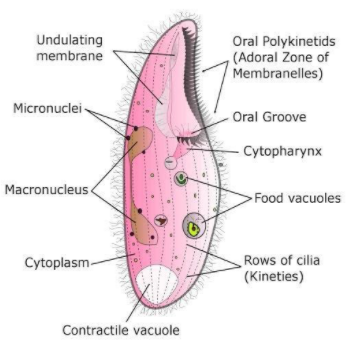
Mode of nutrition in paramecium is
A. Halophytic
B. Holozoic
C. Saprophytic
D. Saprozoic
Answer
500.7k+ views
1 likes
Hint:
Paramecium is a slipper shaped organism. It feeds on microorganisms like algae and yeast. It also feeds on bacteria. The paramaecium projects out its cilia and captures food particles by the process called phagocytosis. The food now goes into the mouth and then to gullet where it is digested. It moves with the help of cilia and captures food along with some amount of water into its oral groove. It is a unicellular organism that captures the whole organism or whole food.

Complete answer:
> Holophytic :- the nutrition in which an organism synthesises its food by the process of photosynthesis that is autotrophic nutrition but paramecium exhibits heterotrophic nutrition. So the option is not correct.
> Holozoic :- the nutrition in which organisms take whole good and first to ingestion like that of paramecium . It obtains food by forming a food vacuole . Hence this option is correct.
> Saprophytic :- the process by which organisms obtain food from dead matter . So this option is not correct.
> Saprozoic :- the process by which organisms obtain food from decaying matter but paramaecium does not obtain nutrition like this. So the option is not true.
Our required answer is b that is holozoic.
Note: The paramecium food consists of small algae , yeasts , protozoa and bacteria. The oral groove of paramecium fuses to form a membrane which takes food particles first to the cytostome and then to the pharynx. It forms food vacuole so the nutrition of paramecium is holozoic that is it engulf full food particles which is then digested.
Paramecium is a slipper shaped organism. It feeds on microorganisms like algae and yeast. It also feeds on bacteria. The paramaecium projects out its cilia and captures food particles by the process called phagocytosis. The food now goes into the mouth and then to gullet where it is digested. It moves with the help of cilia and captures food along with some amount of water into its oral groove. It is a unicellular organism that captures the whole organism or whole food.

Complete answer:
> Holophytic :- the nutrition in which an organism synthesises its food by the process of photosynthesis that is autotrophic nutrition but paramecium exhibits heterotrophic nutrition. So the option is not correct.
> Holozoic :- the nutrition in which organisms take whole good and first to ingestion like that of paramecium . It obtains food by forming a food vacuole . Hence this option is correct.
> Saprophytic :- the process by which organisms obtain food from dead matter . So this option is not correct.
> Saprozoic :- the process by which organisms obtain food from decaying matter but paramaecium does not obtain nutrition like this. So the option is not true.
Our required answer is b that is holozoic.
Note: The paramecium food consists of small algae , yeasts , protozoa and bacteria. The oral groove of paramecium fuses to form a membrane which takes food particles first to the cytostome and then to the pharynx. It forms food vacuole so the nutrition of paramecium is holozoic that is it engulf full food particles which is then digested.
Recently Updated Pages
Master Class 9 General Knowledge: Engaging Questions & Answers for Success

Master Class 9 English: Engaging Questions & Answers for Success

Master Class 9 Science: Engaging Questions & Answers for Success

Master Class 9 Social Science: Engaging Questions & Answers for Success

Master Class 9 Maths: Engaging Questions & Answers for Success

Class 9 Question and Answer - Your Ultimate Solutions Guide

Trending doubts
State and prove Bernoullis theorem class 11 physics CBSE

Who built the Grand Trunk Road AChandragupta Maurya class 11 social science CBSE

1 ton equals to A 100 kg B 1000 kg C 10 kg D 10000 class 11 physics CBSE

State the laws of reflection of light

One Metric ton is equal to kg A 10000 B 1000 C 100 class 11 physics CBSE

Difference Between Prokaryotic Cells and Eukaryotic Cells




